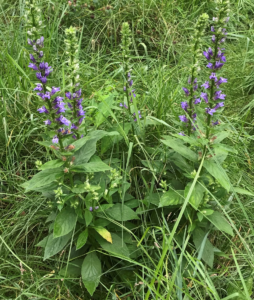
It’s early April and lovely to see a non-native, Snowdrop (Galanthus) bulb gracing the crown of a native, Blue Lobelia plant here in one of Healthy Home Habitats’ demonstration gardens. Many of our native pollinators are now leaving their nearly invisible, hibernating spaces in our gardens. As you probably now know “Pollinators, the small creatures responsible for one out of every three bites of food we eat, employ several strategies to survive winter” UNH, source below. For many, right now used to be time to safely ‘clean up’ ALL of last year’s stalks in our garden as the temperatures are finally, solidly, over 50 degrees. But as I learn more, every doggone day, I will LEAVE the open, hollow stalks of this and other native perennials for our native bees to nest in, not just last winter but also THIS SUMMER. Confusing right?
“TPI members are often asked by gardeners, “when is the best time to cut down stems?” The answer is at least two years (ideally never), which is longer than you might think.” In fact, “Year 2: Bees active during this year will nest in the stems you left standing. They will lay eggs in the stem and provision each egg with a nutritious ball of pollen and nectar. Inside the stem, bees will develop from eggs into larvae and adults that hibernate through winter. Bees won’t emerge from stems until next growing season. Remember to cut back the new, green stems produced this year for next year’s bees.”
New growth will hide these older stalks –for those of us who also still pay attention to how our gardens look. I feel a greater sense of ease knowing that my garden is offering refuge and healthy habitat to the many pollinators: bees, butterflies, moths, and wasps, even flies, beetles and birds that pollinate the fruits and vegetables we and our wildlife love and need.
To me, this garden management choice benefits not only my garden with more butterflies but also my community’s gardens with more pollinators. This is a way to take action TODAY for our climate, for my peace of mind and yet another way to contribute toward a healthier world. I smile each time I see the stalks.
What does the choice look like in your garden?
RESOURCES:
https://extension.unh.edu/blog/2019/10/how-help-bees-butterflies-survive-winter
https://extension.unh.edu/blog/2020/02/who-are-pollinators-nhs-super-seven
https://www.gardeningknowhow.com/ornamental/bulbs/snowdrop/information-about-snowdrops-and-when-to-plant-snowdrop-flower-bulbs.htm
https://plantfinder.nativeplanttrust.org/plant/Lobelia-siphilitica

